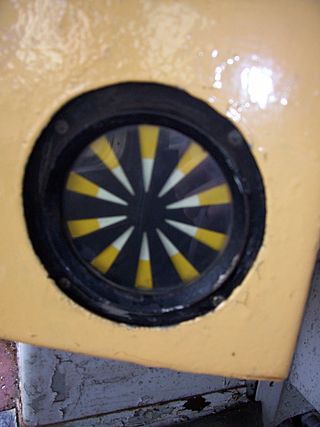The Train Protection & Warning System (TPWS) is a train protection system used throughout the British passenger main-line railway network, and in Victoria, Australia.

A signal passed at danger (SPAD) is an event on a railway where a train passes a stop signal without authority. This is also known as running a red, in the United States as a stop signal overrun (SSO) and in Canada as passing a stop signal. SPAD is defined by Directive 2014/88/EU as any occasion when any part of a train proceeds beyond its authorised movement. Unauthorised movement means to pass:

A balise is an electronic beacon or transponder placed between the rails of a railway as part of an automatic train protection (ATP) system. The French word balise is used to distinguish these beacons from other kinds of beacons.

The Southall rail crash occurred on 19 September 1997, on the Great Western Main Line at Southall, West London. An InterCity 125 high speed passenger train (HST) failed to slow down in response to warning signals and collided with a freight train crossing its path, causing seven deaths and 139 injuries.

Automatic Warning System (AWS) is a railway safety system invented and predominantly used in the United Kingdom. It provides a train driver with an audible indication of whether the next signal they are approaching is clear or at caution. Depending on the upcoming signal state, the AWS will either produce a 'horn' sound, or a 'bell' sound. If the train driver fails to acknowledge a warning indication, an emergency brake application is initiated by the AWS. However if the driver correctly acknowledges the warning indication by pressing an acknowledgement button, then a visual 'sunflower' is displayed to the driver, as a reminder of the warning.

Part of a railway signalling system, a train stop, trip stop or tripcock is a train protection device that automatically stops a train if it attempts to pass a signal when the signal aspect and operating rules prohibit such movement, or if it attempts to pass at an excessive speed.

Cab signaling is a railway safety system that communicates track status and condition information to the cab, crew compartment or driver's compartment of a locomotive, railcar or multiple unit. The information is continually updated giving an easy to read display to the train driver or engine driver.

Automatic train control (ATC) is a general class of train protection systems for railways that involves a speed control mechanism in response to external inputs. For example, a system could effect an emergency brake application if the driver does not react to a signal at danger. ATC systems tend to integrate various cab signalling technologies and they use more granular deceleration patterns in lieu of the rigid stops encountered with the older automatic train stop (ATS) technology. ATC can also be used with automatic train operation (ATO) and is usually considered to be the safety-critical part of a railway system.
Automatic train stop or ATS is a system on a train that automatically stops a train if certain situations occur to prevent accidents. In some scenarios it functions as a type of dead man's switch. Automatic train stop differs from the concept of Automatic Train Control in that ATS usually does not feature an onboard speed control mechanism.

Linienzugbeeinflussung is a cab signalling and train protection system used on selected German and Austrian railway lines as well as on the AVE and some commuter rail lines in Spain. The system was mandatory where trains were allowed to exceed speeds of 160 km/h (99 mph) in Germany and 220 km/h (140 mph) in Spain. It is also used on some slower railway and urban rapid transit lines to increase capacity. The German Linienzugbeeinflussung translates to continuous train control, literally: linear train influencing. It is also called linienförmige Zugbeeinflussung.

PZB or Indusi is an intermittent cab signalling system and train protection system used in Germany, Austria, Slovenia, Croatia, Romania, Israel, Serbia, on two lines in Hungary, on the Tyne and Wear Metro in the UK, and formerly on the Trillium Line in Canada.

The railway signalling system used across the majority of the United Kingdom rail network uses lineside signals to control the movement and speed of trains.
A train protection system is a railway technical installation to ensure safe operation in the event of human error.

Signaling and operation on the Washington Metro system involves train control, station identification, train signaling, signage, and train length. As with any working railroad, communication between train operators, dispatchers, station personnel and passengers is critical. Failures will result in delays, accidents, and even fatalities. It is therefore important that a comprehensive signal system operated by a central authority be in place. This gives individual train and station operators the information they need to safely and efficiently perform their tasks.

The Spa Road Junction rail crash was an accident on the British railway system which occurred during the peak evening rush hour of 8 January 1999 at Spa Road Junction in Bermondsey, in South East London.

The Continuous Automatic Warning System (CAWS) is a form of cab signalling and train protection system used in Ireland to help train drivers observe and obey lineside signals.
Transmission balise-locomotive is a train protection system used in Belgium and on Hong Kong's East Rail line.
EBICab is a trademark registered by Alstom for the equipment on board a train used as a part of an Automatic Train Control system. Three different families exist, which are technically unrelated.
The Chinese Train Control System is a train control system used on railway lines in People's Republic of China. CTCS is similar to the European Train Control System (ETCS).
Automatic Train Protection (ATP) is a method of beacon based railway cab signalling developed by British Rail. The system is only installed on the Great Western Main Line between London Paddington and Bristol Temple Meads, and the Chiltern Main Line from London Marylebone to High Wycombe and Aylesbury.













